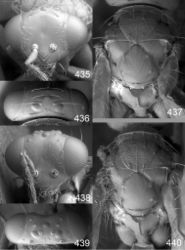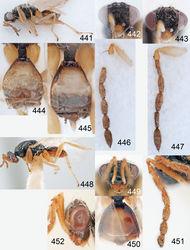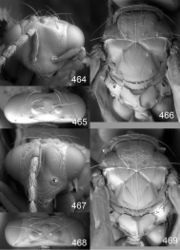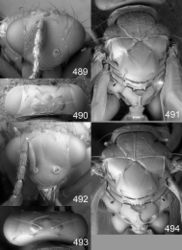| Notice: |
This page is derived from the original publication listed below, whose author(s) should always be credited. Further contributors may edit and improve the content of this page and, consequently, need to be credited as well (see page history). Any assessment of factual correctness requires a careful review of the original article as well as of subsequent contributions.
If you are uncertain whether your planned contribution is correct or not, we suggest that you use the associated discussion page instead of editing the page directly.
This page should be cited as follows (rationale):
Hansson C, Smith M, Janzen D, Hallwachs W (2015) Integrative taxonomy of New World Euplectrus Westwood (Hymenoptera, Eulophidae), with focus on 55 new species from Area de Conservación Guanacaste, northwestern Costa Rica. ZooKeys (485) : 1–236, doi. Versioned wiki page: 2015-03-10, version 69975, https://species-id.net/w/index.php?title=Euplectrus_platyhypenae&oldid=69975 , contributors (alphabetical order): Pensoft Publishers.
Citation formats to copy and paste
BibTeX:
@article{Hansson2015ZooKeys,
author = {Hansson, Christer AND Smith, M. Alex AND Janzen, Daniel H. AND Hallwachs, Winnie},
journal = {ZooKeys},
publisher = {Pensoft Publishers},
title = {Integrative taxonomy of New World Euplectrus Westwood (Hymenoptera, Eulophidae), with focus on 55 new species from Area de Conservación Guanacaste, northwestern Costa Rica},
year = {2015},
volume = {},
issue = {485},
pages = {1--236},
doi = {10.3897/zookeys.485.9124},
url = {http://zookeys.pensoft.net/articles.php?id=4835},
note = {Versioned wiki page: 2015-03-10, version 69975, https://species-id.net/w/index.php?title=Euplectrus_platyhypenae&oldid=69975 , contributors (alphabetical order): Pensoft Publishers.}
}
RIS/ Endnote:
Wikipedia/ Citizendium:
<ref name="Hansson2015ZooKeys">{{Citation
| author = Hansson C, Smith M, Janzen D, Hallwachs W
| title = Integrative taxonomy of New World Euplectrus Westwood (Hymenoptera, Eulophidae), with focus on 55 new species from Area de Conservación Guanacaste, northwestern Costa Rica
| journal = ZooKeys
| year = 2015
| volume =
| issue = 485
| pages = 1--236
| pmid =
| publisher = Pensoft Publishers
| doi = 10.3897/zookeys.485.9124
| url = http://zookeys.pensoft.net/articles.php?id=4835
| pmc =
| accessdate = 2024-12-22
}} Versioned wiki page: 2015-03-10, version 69975, https://species-id.net/w/index.php?title=Euplectrus_platyhypenae&oldid=69975 , contributors (alphabetical order): Pensoft Publishers.</ref>
See also the citation download page at the journal. |
Taxonavigation
Ordo: Hymenoptera
Familia: Eulophidae
Genus: Euplectrus
Name
Euplectrus platyhypenae Howard – Wikispecies link – Pensoft Profile
- Euplectrus platyhypenae Howard, 1885: 26. Lectotype ♂ (USNM), designated here, examined.
Material
Type material: ♂ lectotype of Euplectrus platyhypenae (USNM). Additional material: COSTA RICA: 12♀ 1♂ from Guanacaste on Spodoptera frugiperda; caterpillar project voucher code: 05-SRNP-16047, no barcode (BMNH, CNC, INBio, USNM).
Diagnosis
Lower face black (Figs 637, 638); legs yellowish-brown (Fig. 636); eyes small (Fig. 492); propodeum with a triangular median carina (Fig. 796); petiole 0.6× as long as wide; gaster yellowish-brown with black lateral margins (female, Fig. 639), or black with a large yellowish-white spot in apical ½ (male, Fig. 640); male antenna with scape slightly expanded, widest in the middle, and 3.1× as long as wide (Fig. 643).
Description
Female. Length of body 2.1 mm. Antenna with scape yellowish-white in basal ½ and yellowish-brown in apical ½, pedicel yellowish-brown, flagellomeres yellowish-brown ventrally and dark brown dorsally (Fig. 641). Mandibles and palpi yellowish-white. Head including lower face black and shiny (Fig. 637). Frons close to eyes with two irregular rows of setae (Fig. 492). Vertex with very weak reticulation, smooth lateral to posterior ocelli (Fig. 493). Occipital margin rounded (Fig. 493).
Mesosoma black and shiny (Fig. 636). Each sidelobe of mesoscutum with eight setae. Scutellum 0.9× as long as wide; with weak reticulation (Fig. 494). Dorsellum along anterior margin with a very narrow groove that is divided by longitudinal carinae (Fig. 796), groove medially 0.1× as long as length of dorsellum. Propodeum with very weak reticulation (Fig. 796); anteromedially with a triangular cup; propodeal callus with 15 setae. Legs yellowish-brown (Fig. 636). Fore wing: costal cell with one complete row of setae on ventral surface, and margin with three setae close to marginal vein; with 18 admarginal setae mainly in one row, in apical ⅓ in two rows.
Gaster yellowish-brown with lateral margins black (Fig. 639).
Ratios. HE/MS/WM = 1.5/1.0/1.0; POL/OOL/POO = 6.1/3.6/1.0; OOL/DO = 1.5; WE/WF/WH/HH = 1.0/2.8/4.6/3.4; WH/WT = 1.1; PM/ST = 1.4; TS1/TS2/LT/LT1/LT2/LT3/LT4 = 4.7/2.4/7.8/3.1/1.6/1.0/1.9; LP/WP = 0.6; MM/LG = 1.0.
Male. Length of body 1.7 mm. Scape yellowish-white, slightly expanded and widest in the middle (Fig. 643), sensory pores confined to apicoventral ⅔. Similar to female except gaster shorter and black with a large yellowish-white spot in apical ½ (Fig. 640).
Ratios. LC/WS = 3.1; MM/LG = 1.3.
Hosts and biology
Plathypena scabra (Howard 1885[1]), Spodoptera frugiperda feeding on Cipura campanulata (Iridaceae) (new record) (both hosts are Noctuidae).
Distribution
USA (D.C.) (Howard 1885[1]), Costa Rica (Guanacaste Province) (new record).
Euplectrus platyhypenae was described from one female and one male but no primary type was selected. The male labeled “Euplectrus platyhypenae How. ms.”, “No.657, P.o, July 11.82”, “Type No. 1655, U.S.N.M.”, is hereby selected as lectotype.
The name of this species is frequently misspellt in the literature, as “Euplectrus plathypenae”, as is also the host Spodoptera frugiperda, as “Spodoptera fugiperda”.
Taxon Treatment
- Hansson, C; Smith, M; Janzen, D; Hallwachs, W; 2015: Integrative taxonomy of New World Euplectrus Westwood (Hymenoptera, Eulophidae), with focus on 55 new species from Area de Conservación Guanacaste, northwestern Costa Rica ZooKeys, (485): 1-236. doi
Images
| Figures 393–403. Euplectrus spp. 393–399 Euplectrus johnnoyesi (DHJPAR0028699): 393 habitus in lateral view, female 394 head in frontal view, female 395 head in frontal view, male 396 gaster in dorsal view, female 397 gaster in dorsal view, male 398 antenna in lateral view, female 399 antenna in lateral view, male; 400–403 Euplectrus ireneae (paratype), female: 400 habitus in lateral view 401 head in frontal view 402 gaster in dorsal view 403 antenna in lateral view. |
| Figures 404–409. Euplectrus spp., females. 404–406 Euplectrus johnnoyesi (DHJPAR0028699): 404 head in frontal view 405 vertex 406 mesosoma in dorsal view; 407–409 Euplectrus ireneae (95-SRNP-6049, no barcode): 407 head in frontal view 408 vertex 409 mesosoma in dorsal view. |
| Figures 410–420. Euplectrus spp. 410–416 Euplectrus josefernandezi (DHJPAR0028908): 410 habitus in lateral view, female 411 head in frontal view, female 412 head in frontal view, male 413 gaster in dorsal view, female 414 gaster in dorsal view, male 415 antenna in lateral view, female 416 antenna in lateral view, male 417–420 Euplectrus orias (paratype), female: 417 habitus in lateral view 418 head in frontal view 419 gaster in dorsal view 420 antenna in lateral view. |
| Figures 428–434. Euplectrus lubomirmasneri (DHJPAR0028760): 428 habitus in lateral view, female 429 head in frontal view, female 430 head in frontal view, male 431 gaster in dorsal view, female 432 gaster in dorsal view, male 433 antenna in lateral view, female 434 antenna in lateral view, male. |
| Figures 441–452. Euplectrus spp. 441–447 Euplectrus mikegatesi (DHJPAR0031184): 441 habitus in lateral view, female 442 head in frontal view, female 443 head in frontal view, male 444 gaster in dorsal view, female 445 gaster in dorsal view, male 446 antenna in lateral view, female 447 antenna in lateral view, male 448–452 Euplectrus pachyscaphus (lectotype), female: 448 habitus in lateral view 449 head in frontal view 450 gaster in dorsal view 451 antenna in lateral view 452 head in lateral view. |
| Figures 453–463. Euplectrus spp. 453–459 Euplectrus mikeschauffi (DHJPAR0045452): 453 habitus in lateral view, female 454 head in frontal view, female 455 head in frontal view, male 456 gaster in dorsal view, female 457 gaster in dorsal view, male 458 antenna in lateral view, female 459 antenna in lateral view, male; 460–463 Euplectrus mellipes (lectotype), female: 460 habitus in lateral view 461 head in frontal view 462 gaster in dorsal view 463 antenna in lateral view. |
| Figures 470–478. Euplectrus spp. 470–476 Euplectrus mikesharkeyi (DHJPAR0030516): 470 habitus in lateral view, female 471 head in frontal view, female 472 head in frontal view, male 473 gaster in dorsal view, female 474 gaster in dorsal view, male 475 antenna in lateral view, female 476 antenna in lateral view, male; 477–478 Euplectrus semimarginatus (lectotype), female: 477 habitus in lateral view, head missing 478 gaster in dorsal view. |
| Figures 479–488. Euplectrus spp. 479–485 Euplectrus paulhansoni (DHJPAR0028775): 479 habitus in lateral view, female 480 head in frontal view, female 481 head in frontal view, male 482 gaster in dorsal view, female 483 gaster in dorsal view, male 484 antenna in lateral view, female 485 antenna in lateral view, male; 486–488 Euplectrus solitarius (holotype), female: 486 habitus in lateral view, gaster missing 487 head in frontal view 488 scape and pedicel in lateral view. |
| Figures 489–494. Euplectrus spp., females. 489–491 Euplectrus paulhansoni (DHJPAR0028775): 489 head in frontal view 490 vertex 491 mesosoma in dorsal view; 492–494 Euplectrus platyhypenae (non-types): 492 head in frontal view 493 vertex 494 mesosoma in dorsal view. |
| Figures 636–643. Euplectrus platyhypenae (non-types): 636 habitus in lateral view, female 637 head in frontal view, female 638 head in frontal view, male 639 gaster in dorsal view, female 640 gaster in dorsal view, male 641 antenna in lateral view, female 642 antenna in lateral view, male 643 scape in lateral view, male. |
|
Other References
- ↑ 1.0 1.1 Howard L (1885) Descriptions of North American Chalcididae from the collections of the U.S. Department of Agriculture and of Dr C.V. Riley, with biological notes. (First paper). Together with a list of the described North American species of the family. Bulletin of the United States Department of Agriculture, Bureau of Entomology, No 5: 1–47.













